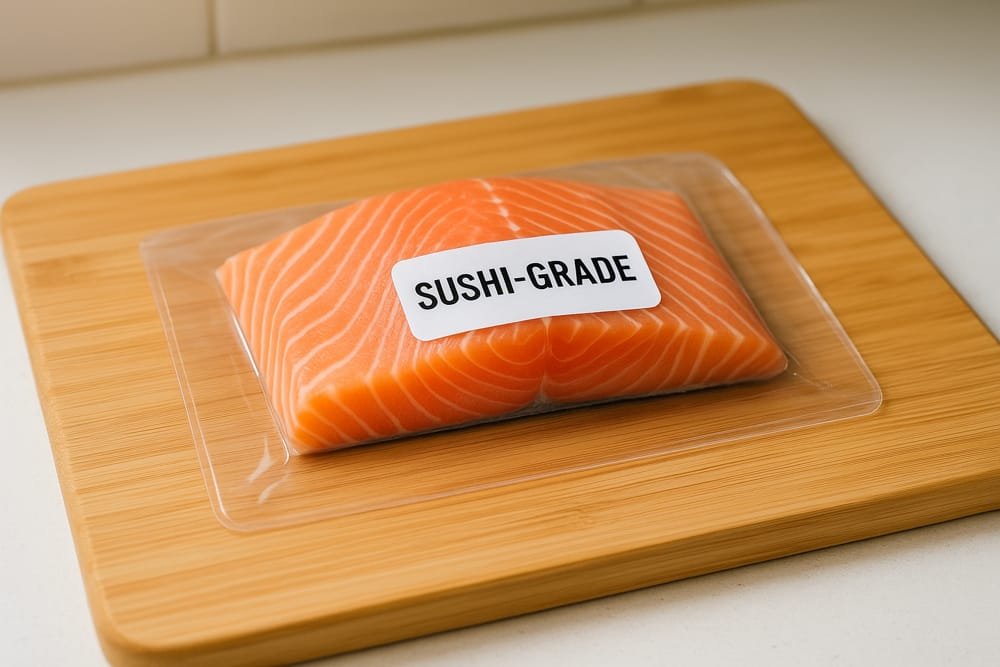When shopping for seafood, especially in preparation for sushi or sashimi, it’s common to encounter the label “sushi-grade.” But what does this term actually mean? Is it a guarantee of safety, quality, or freshness? Unfortunately, many consumers are unaware that “sushi-grade” is not a regulated classification. Despite its widespread use, there is no official definition or certification process enforced by food authorities like the FDA. In this article, we’ll explore the real meaning behind “sushi-grade,” what standards are actually followed, and how to safely select fish for raw consumption. Whether you’re a home cook looking to recreate restaurant-quality sushi or simply a curious shopper, this guide will help you make informed decisions about eating raw seafood.
Contents
- 1 What Does “Sushi-Grade” Actually Mean?
- 2 FDA Guidelines on Raw Fish Consumption
- 3 How Is Sushi-Grade Fish Selected and Handled?
- 4 Common Types of Sushi-Grade Fish
- 5 Can You Trust the “Sushi-Grade” Label?
- 6 How to Choose and Prepare Sushi-Grade Fish at Home
- 7 Sushi-Grade vs. Sashimi-Grade: Is There a Difference?
- 8 Risks of Eating Raw Fish and How to Minimize Them
- 9 Conclusion
- 10 FAQ – Frequently Asked Questions
What Does “Sushi-Grade” Actually Mean?
The term “sushi-grade” is widely used in fish markets and grocery stores, but it’s important to understand that it is not a legally regulated term. In the United States, neither the Food and Drug Administration (FDA) nor any other federal agency officially defines what qualifies as “sushi-grade” or “sashimi-grade.” Instead, the label is applied at the discretion of fishmongers and retailers to indicate that the fish is of high enough quality to be eaten raw.
In practice, “sushi-grade” usually refers to fish that is extremely fresh, has been properly handled, and—most importantly—has been frozen according to FDA guidelines to kill parasites. This freezing process is critical for raw fish consumption, particularly for species like salmon, which are more prone to harboring parasites.
It’s also worth noting that the label is often used as a marketing term to convey premium quality. While many suppliers take great care in selecting and handling “sushi-grade” fish, the lack of standardized criteria means buyers must rely on the integrity and transparency of the vendor. As such, it’s essential to purchase from reputable sources that follow strict safety protocols.
FDA Guidelines on Raw Fish Consumption
Although “sushi-grade” has no official legal definition, the FDA does provide clear guidelines for the safe consumption of raw or undercooked fish. These guidelines focus primarily on freezing practices that are designed to eliminate the risk of parasitic infections.
According to the FDA, fish intended for raw consumption should be:
- Frozen at -4°F (-20°C) or below for 7 days, or
- Frozen at -31°F (-35°C) or below until solid, and then stored at that temperature for 15 hours, or
- Frozen at -31°F (-35°C) or below until solid and stored at -4°F (-20°C) or below for 24 hours.
These freezing conditions are proven to kill parasites like Anisakis, which are commonly found in wild-caught fish. However, some species such as tuna are considered low-risk and are exempt from mandatory freezing due to their natural resistance to parasites.
It’s important to emphasize that freezing does not eliminate all foodborne risks, such as bacteria introduced during handling. That’s why both proper freezing and hygienic processing are essential in making fish safe for raw consumption. Consumers should always ask vendors about their freezing protocols and sourcing practices to ensure safety when choosing raw seafood labeled as “sushi-grade.”
How Is Sushi-Grade Fish Selected and Handled?
The journey of sushi-grade fish begins long before it reaches your plate. From the moment it’s caught, each step in the supply chain must be carefully managed to preserve freshness and minimize health risks. For a fish to be considered sushi-grade, it must be harvested, handled, and processed under strict hygienic conditions.
First, the fish is typically caught using methods that reduce stress and bruising—factors that directly affect quality. Once on board, it is immediately chilled or frozen, often within minutes, to inhibit bacterial growth and preserve texture. High-end suppliers may use a technique known as super-freezing, which brings the temperature down to -76°F (-60°C) to lock in freshness and kill parasites without degrading the quality.
Once the fish arrives at the processing facility, it is cleaned, inspected, and trimmed with sterile equipment in temperature-controlled environments. The final product is vacuum-sealed and shipped or stored under continuous refrigeration.
Sushi-grade fish is not just about the fish itself—it’s also about the integrity of the cold chain and sanitation practices. Any break in this process can compromise safety. That’s why professional sushi chefs and reputable markets only source from trusted suppliers with documented handling protocols.
Common Types of Sushi-Grade Fish
Not all fish are suitable for raw consumption, and among those that are, only a few meet the quality and safety standards typically associated with sushi-grade products. Here are some of the most common types of fish labeled as “sushi-grade”:
- Tuna (Yellowfin, Bluefin, Bigeye, Albacore): Tuna is one of the safest fish to eat raw due to its low risk of parasitic infection. It’s often super-frozen right after catch, preserving its rich texture and flavor.
- Salmon: While highly popular, salmon must always be frozen to FDA standards before being consumed raw, as it’s prone to parasites. Farmed salmon is generally considered safer due to controlled feed and environments.
- Hamachi (Yellowtail): A favorite in sushi bars, especially from Japan or Korea. It has a buttery texture but should be sourced from reputable vendors.
- Scallops (Hotate): When raw, they’re sweet and delicate, but must be harvested and stored properly. Often available as sushi-grade from specialty seafood markets. Can You Eat Scallops Raw? explores this in more detail.
- Mackerel (Saba) and Eel (Unagi): Though commonly served cooked, some preparations may involve cured or lightly treated versions for raw applications.
Each fish type has unique handling requirements and risk profiles. That’s why knowing the origin and treatment history is essential when selecting fish for raw use.
Can You Trust the “Sushi-Grade” Label?
The short answer: not always. Since the term “sushi-grade” is not regulated by any government agency, there’s no guarantee that seafood with this label has met any specific safety or quality standard. This makes consumer education and vendor transparency crucial.
While many reputable fishmongers and seafood retailers use “sushi-grade” to indicate that the product is safe for raw consumption, it’s ultimately a marketing term. It does not legally require adherence to FDA freezing protocols, nor does it guarantee that the fish was handled in a sterile environment.
That said, high-quality vendors will often follow strict internal standards that exceed FDA recommendations. These may include:
- Maintaining cold chain logistics from ocean to counter
- Using only parasite-resistant or properly frozen fish
- Regular third-party safety inspections
To protect yourself as a consumer:
- Ask about the freezing and handling process
- Request documentation or origin details if available
- Buy from trusted suppliers or Japanese specialty markets
Ultimately, the safest approach is to treat “sushi-grade” as a starting point for inquiry, not a definitive seal of safety. Trust is earned not by labels, but by clear, traceable practices.
How to Choose and Prepare Sushi-Grade Fish at Home
Making sushi at home can be both rewarding and risky—especially when working with raw fish. To ensure safety, selecting and preparing sushi-grade fish requires a thoughtful approach.
1. Buy from Trusted Sources
Always purchase from seafood markets or suppliers that specialize in sashimi or sushi-grade offerings. Look for vendors who:
- Follow FDA-recommended freezing procedures
- Offer transparent sourcing information
- Keep fish properly refrigerated and well-labeled
Avoid buying fish from general grocery stores unless it’s explicitly labeled as safe for raw consumption and handled with care.
2. Ask the Right Questions
When shopping, don’t hesitate to ask:
- Has this fish been frozen to FDA standards?
- Was it frozen immediately after being caught?
- Can I see the date of catch or packaging?
If a vendor cannot answer confidently or provide documentation, it’s safer to walk away.
3. Home Handling Best Practices
Once at home:
- Keep the fish refrigerated at all times
- Use separate cutting boards and knives for raw and cooked food
- Wash hands and surfaces thoroughly
- Consume the fish the same day if possible
Proper technique is just as important as proper sourcing. Even the best-quality fish can become unsafe if handled poorly at home.
For a deeper dive into sourcing quality fish, explore our related guide: How to Choose Sashimi-Grade Seafood.
Sushi-Grade vs. Sashimi-Grade: Is There a Difference?
You may have seen both “sushi-grade” and “sashimi-grade” labels used interchangeably. In most cases, these terms mean the same thing—premium-quality fish deemed safe for raw consumption—but let’s break it down:
- Sushi-Grade typically implies the fish is suitable to be served over vinegared rice, as in nigiri or maki rolls.
- Sashimi-Grade emphasizes that the fish is pure and fresh enough to be served alone in thin slices, without additional rice or garnishes.
There is no legal or scientific distinction between the two. Both are marketing terms, and neither is regulated by the FDA or any food safety authority. However, in culinary settings, “sashimi-grade” may be held to slightly stricter freshness standards because the fish will be the sole focus of the dish.
Bottom line: whether it’s labeled sushi-grade or sashimi-grade, always verify that the product was frozen and handled correctly before eating it raw.
Risks of Eating Raw Fish and How to Minimize Them
Despite its popularity, eating raw fish always carries some risk. The primary concerns include:
1. Parasites
Species like salmon are known carriers of parasites such as Anisakis. If the fish isn’t frozen to FDA standards, consuming it raw can lead to serious gastrointestinal issues.
2. Bacteria and Viruses
Even if parasites are killed through freezing, bacteria like Listeria or Salmonella may still pose a risk—especially if the fish is mishandled during processing or preparation.
3. Who Should Avoid Raw Fish
- Pregnant women
- Infants and young children
- Elderly individuals
- Immunocompromised individuals (e.g., cancer patients, people with chronic illnesses)
4. Risk Reduction Tips
- Only buy from reputable sources with clear safety practices
- Freeze fish to FDA-approved temperatures before use (unless already frozen)
- Avoid cross-contamination at home during preparation
- Eat it fresh, ideally within 24 hours of purchase
Being informed and cautious is the best way to enjoy the flavor and experience of raw seafood while keeping foodborne illness at bay.
Conclusion
“Sushi-grade” is a widely used yet misunderstood term in the seafood industry. While it often signals that a fish is fresh and safe for raw consumption, it’s not a regulated label—and therefore, not a guarantee of safety. True assurance comes from understanding FDA guidelines, verifying freezing and handling practices, and sourcing from reputable vendors.
If you’re preparing sushi or sashimi at home, being informed is your best defense against foodborne illness. Choose fish that has been properly frozen, handle it hygienically, and consume it promptly. Ultimately, “sushi-grade” should serve as a prompt to ask deeper questions—not a substitute for food safety knowledge.
FAQ – Frequently Asked Questions
1. Is sushi-grade fish safe to eat raw?
Sushi-grade fish can be safe to eat raw if it has been properly frozen according to FDA guidelines to kill parasites and handled under hygienic conditions. However, the label itself is not regulated, so trust in your source is essential.
2. What temperature kills parasites in fish?
To kill parasites, the FDA recommends freezing fish at:
- -4°F (-20°C) for 7 days, or
- -31°F (-35°C) until solid, followed by 15 hours at that temperature, or
- A combination of freezing and storage below -4°F for at least 24 hours.
These freezing protocols are effective against common parasites like Anisakis.
3. Can I freeze fish at home to make it sushi-grade?
Typical home freezers do not reach the extremely low temperatures required to kill parasites reliably. Therefore, freezing fish at home does not necessarily make it safe for raw consumption unless you own a commercial-grade deep freezer. It’s always safer to buy fish that has been professionally frozen and labeled for raw use.
4. Why is sushi-grade fish more expensive?
The higher price reflects the costs associated with:
- Careful sourcing and rapid freezing
- Maintaining cold chain logistics
- Higher safety standards and perishability
- Selection of premium cuts suitable for raw consumption
These steps ensure both safety and optimal texture/flavor for raw dishes.
5. Is Costco or Whole Foods sushi-grade fish reliable?
Both Costco and Whole Foods may sell fish labeled as sushi-grade, but it’s important to verify:
- Whether it was frozen to FDA standards
- How recently it was thawed
- If staff can provide handling/safety information
These retailers often have solid food safety practices, but always ask questions to confirm.



